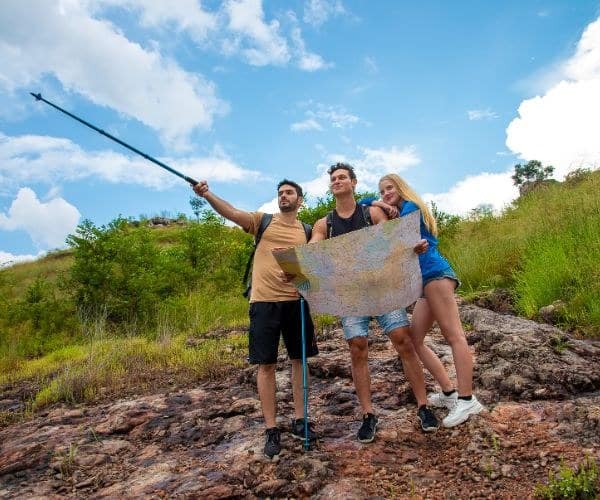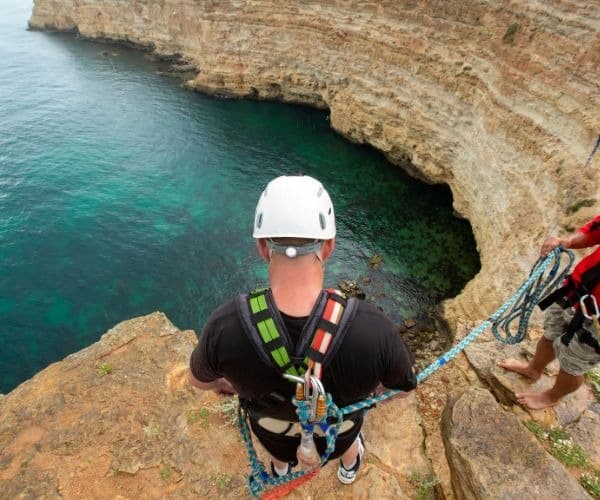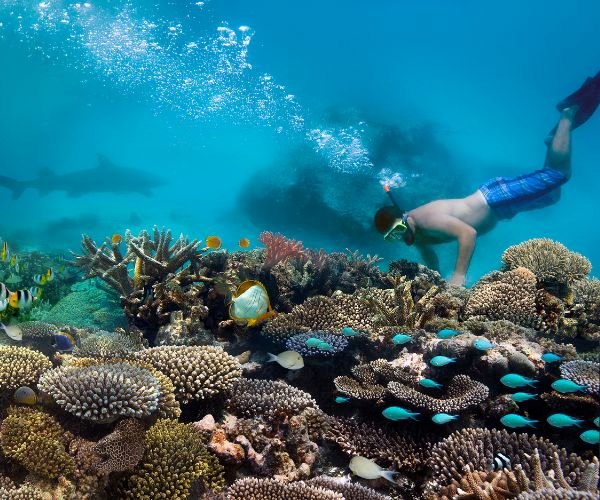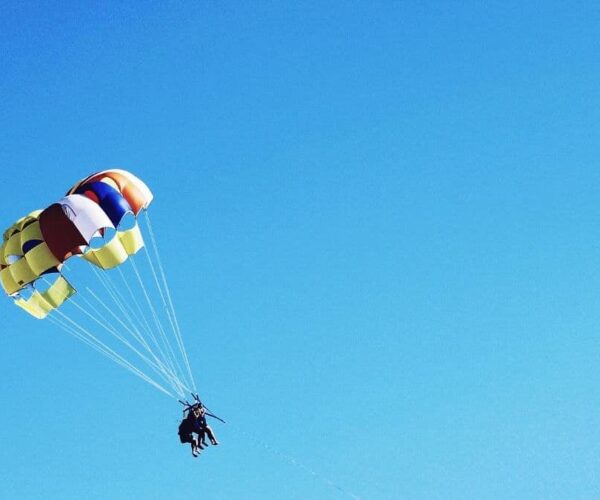Australia is more than a country – it’s a vast continent filled with dramatic contrasts and limitless opportunities for adventure seekers. From deserts and dense rainforests to coral reefs and rugged mountains, it offers adrenaline-packed experiences for every type of traveller. Whether you’re swimming with whale sharks, hiking through ancient landscapes, or canyoning in waterfalls, Australia delivers thrills you won’t find anywhere else.
Thrill-seekers will find endless extreme sports opportunities across the country. You can go skydiving over iconic beaches, bungee jump from historic bridges, or take on white-water rafting in fast-flowing rivers. Surfing enthusiasts will find world-class waves along both the east and west coasts, while rock climbers can scale sea cliffs and famous formations like Tasmania’s Totem Pole. Canyoning and abseiling in gorges offer heart-pumping experiences, and kiteboarding or windsurfing in windy coastal regions provides high-speed aquatic challenges. Adventure tourism operators cater to both beginners and experts, ensuring safety while maximising excitement.
This guide covers everything you need to know about planning an adventure travel trip to Australia, from the best activities and itineraries to the risks you should prepare for. Let’s dive in.
Best adventure travel activities in Australia
Australia offers a wide range of activities for adventure seekers. Some of the top adventures include:
Water & marine activities
- Great Barrier Reef (Queensland): Snorkelling and scuba diving among vibrant marine life.
- Ningaloo Reef (Western Australia): Swim with whale sharks between April and July.
- Shark cage diving (South Australia): Face-to-face encounters with great white sharks.
- Surfing: Iconic spots include Bondi Beach, Byron Bay, and Margaret River.
Land & mountain activities
- Blue Mountains (NSW): Abseiling, canyoning, and climbing.
- Larapinta Trail (Northern Territory): Multi-day trekking through the Red Centre.
- Cradle Mountain (Tasmania): Hiking, wildlife spotting, and alpine scenery.
- Totem Pole (Tasmania): Sea stack climbing for experienced climbers.
Wilderness & outback activities
- Uluru & Kata Tjuta (Northern Territory): Hiking and cultural exploration.
- Kimberley Region (Western Australia): Remote gorges, waterfalls, and 4WD expeditions.
- Fraser Island (Queensland): 4WD adventures, camping, and freshwater lakes.
- Franklin River (Tasmania): Multi-day white-water rafting through untouched wilderness.
Traveling to Australia: essential entry information

Entry and visas
Unless you’re an Australian citizen, you’ll need a valid visa to enter. Most short-term travellers can apply online for an Electronic Travel Authority (ETA) or visitor visa. Make sure you check requirements in advance, as rules vary by nationality.
Biosecurity and customs
Australia has some of the strictest biosecurity laws in the world. Items such as fresh food, seeds, soil, and animal products must be declared at customs. Failing to do so can result in hefty fines. Always check the official guidelines before you pack.
Health and vaccinations
While no specific vaccines are required for most travellers, it’s wise to be up to date on routine shots. If you’re heading to tropical or remote regions, consult a travel doctor about additional recommendations.
When to visit: best times for each region
Australia is vast, and its climate shifts dramatically depending on where you go. Understanding seasonal patterns can make the difference between a comfortable trip and one filled with weather-related challenges:
- Northern Australia (Darwin, Cairns): Tropical climate with wet and dry seasons. The dry season (May–October) is ideal for reef tours and hiking. The wet season (November–April) brings heavy rains and high humidity.
- Southern Australia (Sydney, Melbourne, Adelaide): Four distinct seasons. Summers (Dec–Feb) are hot with festivals, autumn (Mar–May) is cooler with colourful landscapes, winter (Jun–Aug) is mild but chilly, and spring (Sep–Nov) is perfect for wildflowers.
- The Outback: Summer temperatures can exceed 40°C, making travel dangerous. Cooler months (May–September) are ideal, but nights can be freezing.
- Alpine Regions: Snowy Mountains and Victorian Alps are great for skiing June–September; other months offer hiking and mountain biking.
Practical tips for a safe and enjoyable adventure

Packing and gear
Getting ready for an Australian adventure involves careful preparation. Packing the right clothing and gear is crucial. Lightweight clothes for heat, warm layers for cold nights, sturdy hiking boots, insect repellent, sunscreen, a hat, a reusable water bottle, and a compact first-aid kit are all essential. Depending on your planned activities, you may also need snorkel gear, trekking poles, or climbing equipment, although many operators provide gear hire.
Transport and connectivity
Transport across Australia requires planning because the country is so large. Domestic flights can save time, while campervans and 4WD rentals offer flexibility for long road trips. Trains and long-distance buses connect many cities and regions. Connectivity is another consideration: while cities and towns have Wi-Fi, remote areas often lack service, so carrying a local SIM or satellite device can be useful.
Budgeting for adventures
Scuba diving trips can range from $150 to $400, guided hikes from $100 to $300, and multi-day tours can exceed $1,000. Be sure to factor in park fees, permits, and gear hire. Planning your budget carefully ensures a smooth adventure without financial stress.
Regional adventures: discover unique experiences

Queensland adventures
- Explore the Great Barrier Reef through diving and snorkelling.
- Hike through the Daintree Rainforest with guided tours.
- Sail the Whitsundays and discover hidden islands.
- Try white-water rafting in the Tully River.
New South Wales adventures
- Go canyoning and climbing in the Blue Mountains.
- Walk along the scenic coastal trails from Sydney to Byron Bay.
- Take a hot air balloon ride over the Hunter Valley.
- Surf at iconic beaches like Bondi and Byron.
Victoria adventures
- Drive along the Great Ocean Road and explore coastal cliffs.
- Hike the trails of the Grampians National Park.
- Enjoy snow sports at Mount Buller and Falls Creek.
- Kayak or mountain bike in national parks.
Northern Territory adventures
- Join wildlife safaris in Kakadu National Park.
- Hike around Uluru and Kata Tjuta, exploring Aboriginal culture.
- Camp under the stars in the desert.
- Explore Arnhem Land with proper permits.
Western Australia adventures
- Snorkel and swim with whale sharks at Ningaloo Reef.
- Embark on 4WD adventures in the Kimberley region.
- Sandboard the dunes of the Pinnacles Desert.
- Cycle and tour wildlife at Rottnest Island.
South Australia adventures
- Experience shark cage diving at Port Lincoln.
- Trek the Flinders Ranges.
- Combine wine tours in Barossa Valley with outdoor activities.
Tasmania adventures
- Hike the multi-day Overland Track.
- Go white-water rafting on the Franklin River.
- Explore the remote wilderness and wildlife.
- Tackle alpine adventures at Cradle Mountain.
Risks and safety considerations for adventure travel

Adventure travel is exhilarating, but it comes with certain risks. Knowing what to watch for is essential:
Wildlife hazards
- Box jellyfish, Irukandji jellyfish, and sharks in northern waters.
- Crocodiles in northern rivers and coastal areas – always look for and follow warning signs.
- Venomous snakes and spiders in bushland; encounters are rare but possible.
Environmental dangers
- Extreme heat and dehydration, especially in the Outback and desert areas.
- Bushfires in summer; always check fire danger warnings.
- Rip currents at unpatrolled beaches – swim only at lifeguard-supervised locations.
Remoteness and logistics
- Sparse services: towns can be hundreds of kilometres apart in remote regions.
- Limited mobile coverage; consider a satellite phone for long expeditions.
- Emergency response may be hours away; travel insurance with evacuation cover is essential.
Travel insurance and why it matters
Adventure activities are often not covered by standard travel insurance. If you plan to dive, trek, or go rafting, it’s important to choose a policy with adventure travel coverage. This will protect you in case of medical emergencies, lost equipment, and evacuations.
Adventure travel insurance is essential for several reasons. Many policies exclude high-risk activities such as scuba diving, bungee jumping, skydiving, or multi-day treks. Remote rescues can cost tens of thousands of dollars without coverage. Insurance can also protect your equipment, including surfboards, diving gear, or cameras. Additionally, insurance can reimburse costs from trip disruptions caused by bushfires, cyclones, or floods. Having the right insurance provides peace of mind, allowing you to focus on your experience rather than the risks.
When choosing a provider, compare coverage, check claim limits, and make sure your policy matches the specific activities you plan to undertake.
Gap year travellers: adventure, work, and sightseeing

Australia is a hotspot for gap year travellers looking to combine adventure with work and sightseeing:
- Working holidays: With a WHV (Working Holiday Visa), travellers can earn money while exploring. Popular jobs include fruit picking, hospitality, and tour guiding.
Backpacking adventures: Hostels, campervans, and shared travel options make long-term exploration affordable.
Sightseeing highlights: Don’t miss iconic sites like the Sydney Opera House, Great Ocean Road, Uluru, Daintree Rainforest, and Cradle Mountain.
Volunteer & eco-travel: Combine travel with conservation projects, wildlife care, and reef restoration programs.
Gap year travellers can pace their adventure while gaining work experience, making travel more sustainable and immersive.
Get Adventure Travel Insurance from SportsCover Direct
Australia’s landscapes are perfect for adrenaline-pumping adventures, but when you’re hiking remote trails, diving with whale sharks, or tackling white-water rapids, it’s important to be prepared for the unexpected. That’s where specialist adventure travel insurance comes in.
SportsCover Direct provides Adventure Travel Insurance while also covering over 500 activities, including trekking, scuba diving, surfing, climbing, and multi-day wilderness expeditions. Whether your adventure is moderate or extreme, their policies protect you for emergency medical treatment, repatriation, trip cancellations, lost or damaged equipment, and even search and rescue operations.
With worldwide coverage, SportsCover Direct’s Adventure Travel Insurance gives you peace of mind while exploring Australia’s deserts, mountains, and coastal waters.
Get a quote online today and focus on the thrills while knowing you’re financially protected.
This blog has been created as general information and should not be taken as advice. Make sure you have the correct level of insurance for your requirements and always review policy documentation.